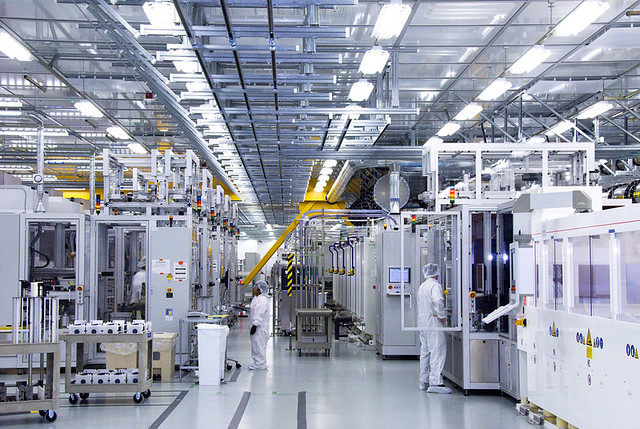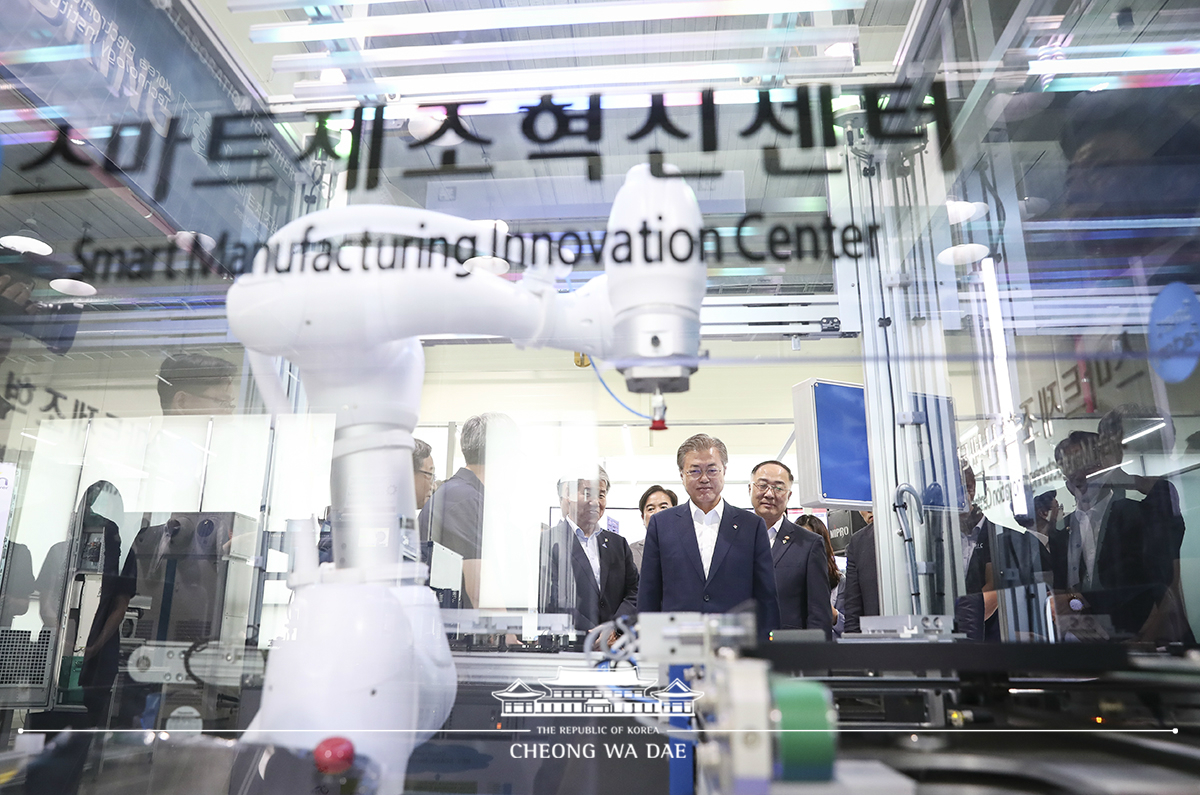정부가 제조업 부흥을 통해 세계 4대 제조강국 도약을 위한 제조업 르네상스 비전 및 전략을 발표하였다. 제조업 르네상스 추진을 통해 정부는 제조업 부가가치율을 현재 25%에서 선진국 수준인 30%로 끌어올려 산업구조를 혁신할 계획이다. 또 제조업 생산액 중 신산업과 신품목 비중을 16%에서 30% 수준으로 높이고, 세계 일류 기업을 2배 이상으로 확대하여 수출규모기준 세계 4대 제조 강국으로 도약하도록 한다. 제조업 르네상스 비전 달성을 위해 정부는 4대 추진전략을 중점적으로 추진한다.
| 제조업 부가가치율 25%에서 30%로 높인다
| 스마트화, 친환경화, 융복합화로 산업구조 혁신
| AI 팩토리 2천개 구축 및 AI 기반 산업지능화 추진
정부가 19일, 제조업 부흥을 통해 세계 4대 제조강국 도약을 위한 ‘제조업 르네상스 비전 및 전략’을 발표하였다.

제조업 르네상스 비전 및 전략 발표
제조업 르네상스 추진을 통해 정부는 제조업 부가가치율을 현재 25%에서 선진국 수준인 30%로 끌어올려 산업구조를 혁신할 계획이다.
또 제조업 생산액 중 신산업과 신품목 비중을 16%에서 30% 수준으로 높이고, 세계 일류 기업을 2배 이상으로 확대하여 수출규모기준 세계 4대 제조 강국으로 도약하도록 한다.
제조업 르네상스 비전 달성을 위해 정부는 4대 추진전략을 중점적으로 추진한다.
첫 번째 전략은 스마트화, 친환경화, 융복합화를 통한 산업구조 혁신 가속화다.
먼저 스마트화다. 정부는 2022년까지 중소기업을 대상으로 스마트팩토리 3만개를 보급하고, 2030년까지 스마트 산단 20개를 조성한다. 2030년까지 AI 팩토리 2천개를 구축하고 ‘제조업 혁신 특별법’ 제정 등 제조업 전반에 걸쳐 AI 기반 산업지능화를 본격 추진한다.
그리고 스마트팩토리 데이터를 축적하여 AI 기반 서비스를 지원하는 데이터 센터를 구축하고, 스마트공장에 사용되는 핵심 S/W, 로봇, 센서, 장비 등 스마트제조혁신 공급산업을 육성한다.
다음으로 친환경화다. 정부는 친환경차, 선박, 공기산업, 에너지신산업 등 친환경 시장 선점을 위해 기술개발, 인프라 구축, 수요창출을 병행 지원한다.
마지막으로 융복합화다. 정부는 제조업과 서비스업, 다른 업종 간 융합을 지원해 부가가치를 제고한다. 자율운행 자동차 및 선박, 스마트 의류, 스마트 가전, 서비스 로봇 등 융합신상품 핵심 기술 개발 및 공공실증을 통해 사업화를 촉진할 것이다.
또 규제샌드박스와 규제자유특구를 통해 융합 제품․서비스 규제를 해소하고, 모빌리티 서비스, 바이오산업 등 가치관의 충돌이 있는 업역은 정부가 중재하여 신상품 및 서비스 출시가 가능한 환경을 조성한다.
두 번째 전략은 신산업을 새로운 주력산업으로 육성하고, 기존주력산업은 혁신을 통해 탈바꿈시키는 것이다. 이를 위해 정부는 지속적인 신산업 창출에 국가적 역량과 자원을 결집한다.
빅데이터 플랫폼, AI 허브, 5G 네트워크 등 DNA(Data, Network, AI) 인프라에 집중할 것이며, 현 주력산업을 고부가 유망 품목 중심으로 전환을 가속화한다.
소재,․부품․장비산업을 집중 육성할 것이며, 상시적 사업재편과 기업 구조 혁신을 촉진한다. 산업단지는 신산업 창출과 제조업 혁신의 전진기지로 전환될 것이며, 수출지원은 강화된다.
세 번째 전략은 산업생태계를 도전과 축적 중심으로 전면 개편하는 것이다. 이를 위해 제조업이 필요로 하는 인재를 적기에 충분히 양성하도록 지원할 것이며, 도전, 속도, 축적에 기반을 두고 R&D 체계를 전면 개편한다. 또한, 혁신 제조기업의 도전과 성장을 뒷받침하는 금융 체계를 구축한다.
네 번째는 투자 확대와 혁신 조성을 위한 정부 역할의 강화다. 정부는 외국에 나가지 않고 국내에 투자해도 경쟁력을 갖출 수 있도록 기업하기 좋은 환경을 조성하고, 과감하게 지원을 확대할 것이다. 또 정부 퍼스트 바이어(First Buyer)로서 선도적으로 수요를 창출하고, 대규모 실증을 확대한다.
제조업 르네상스 추진을 통해 정부는 제조업 부가가치율을 선진국 수준인 30%로, 노동생산성을 현재보다 40% 이상 높일 계획이다.
시스템반도체, 바이오헬스, 친환경모빌리티 등을 우리 경제의 새로운 먹거리로 선택한 정부는 동시에 차세대반도체, 첨단가공장비, 이차전지, 고부가철강, 산업용섬유 등 고부가 유망품목 중심으로 주력산업의 성장을 지속할 예정이다.
제조업 르네상스 비전 및 전략은 내일 산업단지 현장에서 “세계 4대 제조강국 Made in Korea"라는 슬로건 하에 개최된“제조업 르네상스 비전 선포식”에서 정식 발표됐다.
이 자리에는 관련 정부부서는 물론, 세계일류기업, 스마트제조혁신센터 산학협력프로그램에 참여하는 대학생, 유관기관 등 150여명이 참석했다.
정부는 앞으로 ‘제조업 르네상스 전략 회의’를 통해 미래차 등 업종별 전략과 기업 환경 개선, 인재양성 등의 후속 과제를 지속 논의해 나갈 계획이며, 후속 대책도 추진해 나갈 예정이다.

제조업 르네상스 비전 선포식 참석한 문재인 대통령
(출처: 청와대)
경기도 안산스마트제조혁신센터에서 19일 열린 제조업 르네상스 비전 및 전략 선포식에서 문재인 대통령은 “4차 산업혁명과 신흥 제조강국의 부상으로 지금까지의 추격형 전략이 한계에 도달”했다면서, “환경규제와 보호무역 확산, 생산비용 상승 등으로 제조기업들이 어려움을 호소하고 있다”고 말했다.
이어 “과거의 추격형 산업전략은 더 이상 우리 경제의 해법이 되지 못하며 혁신 선도형 산업구조로의 전환이 시급”하다면서 “한국 산업생태계를 도전과 축적, 사람과 기술 중심으로 전환할 것”이라고 말했다.
그러면서 “제조업 혁신이 지속적인 동력을 가질 수 있도록, 대통령 주재 민관 합동 제조업 르네상스 전략회의를 신설할 것”이며, “생산비용, 노사문제, 환경규제와 같은 기업의 애로사항을 함께 논의하고 기업들의 목소리에 귀를 기울여 새로운 제도의 도입에 따른 어려움을 함께 해결할 것”이라 밝혔다.

